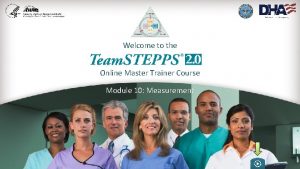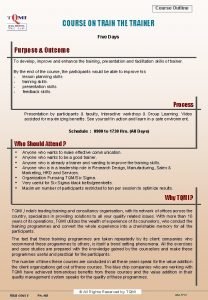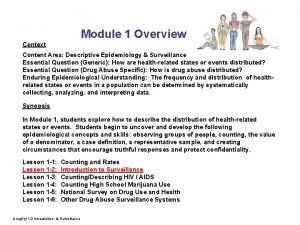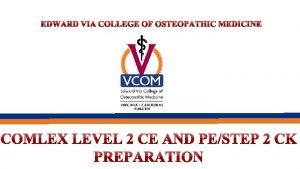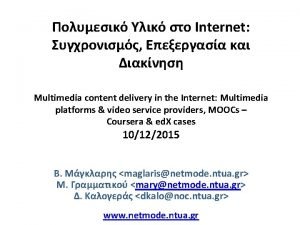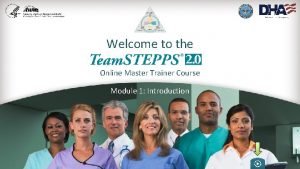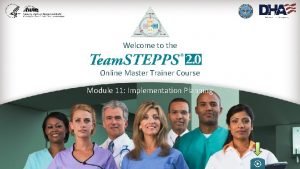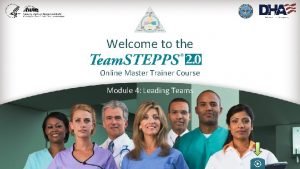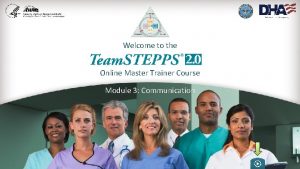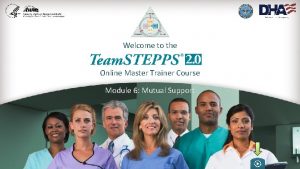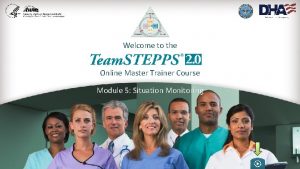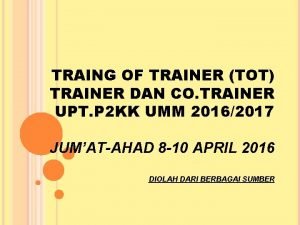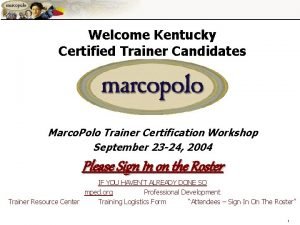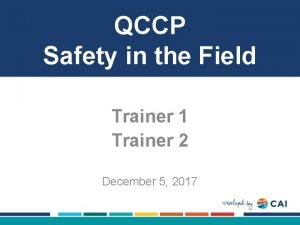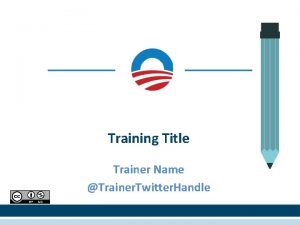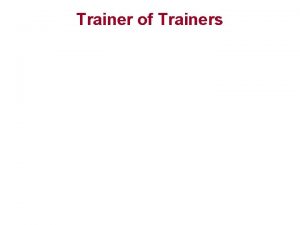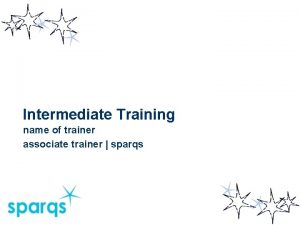Welcome to the Online Master Trainer Course Module

























- Slides: 25

Welcome to the Online Master Trainer Course Module 2: Team Structure

How This Online Course Works This course will walk you through the Team. STEPPS content just as you will present it when you train your colleagues and staff It teaches you all the concepts that comprise the Team. STEPPS initiative While also teaching you to teach Team. STEPPS to your colleagues Use the navigation buttons in the lower right to work through the online modules Select here to move back to the previous slide Module 2: Team Structure Select here to move to the next slide 2 of 25

The Materials You Will Use When you deliver your training you will use these materials: • Instructor Manual – Course Management Guide – Instructor guides – Course slides – Measurement tools • Customizable materials • Videos Module 2: Team Structure Select here to review materials on the Team. STEPPS website 3 of 25

Please Print the Instructor Guide To best use this online module, please print the Module 2 Instructor Guide, located here. You may also want to print the Team. STEPPS Pocket Guide Then we will proceed to work through the slides you will use to train – just as if you are delivering this module at your facility. Module 2: Team Structure 4 of 25

Cover Slide: Prepare To promote teamwork you must first understand the structure of teams See pages 3 -4 in the Instructor Guide for details on how to prepare to deliver this module Module 2: Team Structure 5 of 25

Slide 2: Objectives Use slide 2 to introduce your learners to what will be covered in this module See page 5 in the Instructor Guide for details on how to facilitate this slide Module 2: Team Structure 6 of 25

Slide 3: Introduce Team Structure Using slide 3, you will provide an overview of Team Structure See page 6 in the Instructor Guide for details on how to facilitate this slide Module 2: Team Structure 7 of 25

Slide 4: What Defines a Team? “Two or more people who interact dynamically, interdependently, and adaptively toward a common and valued goal, have specific roles or functions, and have a time-limited membership” Module 2: Team Structure 8 of 25

Slide 5: Teams & Teamwork Exercise Download the Teams & Teamwork Exercise Sheet Worksheet questions: • Who are the team members in your area or unit? • What is the goal of your unit or work area? • What characteristics make a group a team? See page 8 in the Instructor Guide for details on this exercise Module 2: Team Structure 9 of 25

Complete Your Own Worksheet Download and print the worksheet at right. Use it to answer these questions: • Who are the team members in your immediate work area or unit? • What is the Goal of your unit or work area? • List 2 -3 characteristics that make the group a team Select here to download and print the worksheet and answer the question. Module 2: Team Structure 10 of 25

Worksheet Discussion Review your worksheet answers: • Did you include patients in your list of team members? • A key concept of team structure is partnering with the patient and their family • As you are teaching, ask the group to share some of their answers. Module 2: Team Structure 11 of 25

Partnering With the Patient (Slide 6) Strategies for involving patients in their care: • Include patients in bedside rounds • Conduct handoffs at the patient’s bedside • Provide patients with tools for communicating with their care team • Involve patients in key committees • Actively enlist patient participation Module 2: Team Structure See Instructor Guide, pages 9 -10 12 of 25

Clinical Team Responsibilities (Slide 7) Embrace patients and their families as valuable and contributing partners in patient care • • Listen to patients and their families Ask patients’ preference regarding involvement Ask patients about their concerns Speak to them in lay terms Allow time for patients and families to ask questions Give them access to relevant information Ask for their feedback Encourage patients and their families to proactively participate in patient care Module 2: Team Structure 13 of 25

Patient & Family Responsibilities (Slide 8) Provide accurate patient information Comply with the prescribed plan of care (e. g. , schedule and attend appointments as directed) Ask questions and/or voice any concerns regarding the plan of care Monitor and report changes in the patients’ condition Manage family members Follow instructions of the clinical team Module 2: Team Structure 14 of 25

Multi-Team System (MTS) for Patient Care Module 2: Team Structure 15 of 25

Slide 10: A Core Team is… A group of care providers who work interdependently to manage a set of assigned patients from point of assessment to disposition Module 2: Team Structure Core Team members have the closest contact with the patient! 16 of 25

Slide 11: A Contingency Team is… A time-limited team formed for emergent or specific events and composed of members from various teams Module 2: Team Structure The Team. STEPPS Rapid Response Systems Guide is available from AHRQ 17 of 25

Slide 12: A Coordinating Team is… A team comprising those work area members who are responsible for managing the operational environment that supports the Core Team Module 2: Team Structure 18 of 25

Slide 13: Ancillary & Support Services Ancillary Services provide direct, taskspecific, time-limited care to patients. Support Services provide indirect service-focused tasks that help to facilitate the optimal health care experience for patients and their families Module 2: Team Structure 19 of 25

The Role of Administration is to… Establish and communicate vision Develop policies and set expectations for staff related to teamwork Support and encourage staff during implementation and culture change Hold teams accountable for team performance Define the culture of the organization Module 2: Team Structure ADMINISTRATION 20 of 25

Slide 15: Team Structure Video As you watch the video, consider how the lack of team structure plays a role in the situation shown. See page 19 -20 in the Instructor Guide for details on how to facilitate this slide Select the image to launch a web browser where you can watch the video Module 2: Team Structure 21 of 25

Slide 16: Video Discussion Let’s discuss what you saw in the video: What members of the teams were involved? • • Who from the Core Team? Who from the Coordinating Team? From the Contingency Team? From the Ancillary & Support Services? Where did the breakdowns occur? See pages 19 -20 in the Instructor Guide Module 2: Team Structure 22 of 25

Slide 17: Applying Team. STEPPS Exercise Close Module 2 by answering these questions: • Who are the members of the team experiencing a teamwork issue? • Which team or teams within your multi-team system are experiencing the teamwork issue? • Which teams interact with or are otherwise affected by the team(s) experiencing the issue? Select here to download and print the Team. STEPPS Implementation Worksheet and answer the questions. Module 2: Team Structure 23 of 25

Module 2 Summary In this module you learned to: • Discuss benefits of teamwork and team structure • Define a “team” • Identify the role of patients and their families as part of the care team • Describe the components and composition of a multi-team system Module 2: Team Structure 24 of 25

Module 2 Conclusion This concludes Module 2 of the Team. STEPPS 2. 0 Online Master Trainer Course Module 2 Go to Module 3 Module 2: Team Structure 25 of 25
 Teamstepps master trainer
Teamstepps master trainer Master trainer 45
Master trainer 45 Train the trainer objectives
Train the trainer objectives Train the trainer outline
Train the trainer outline C device module module 1
C device module module 1 Supervisor safety leadership training
Supervisor safety leadership training Course module sample
Course module sample Wise men three clever are we
Wise men three clever are we Hello my students. how are you
Hello my students. how are you Cut brick lengthwise
Cut brick lengthwise Course number and title
Course number and title Course interne course externe
Course interne course externe Welcome to our online class
Welcome to our online class Welcome access online
Welcome access online Welcome to my online class
Welcome to my online class Cryptography online course
Cryptography online course Supplemental online coursework
Supplemental online coursework Healthy workplace
Healthy workplace Online cryptography course
Online cryptography course Marksmanship instructor
Marksmanship instructor Ptit safe driving and awareness course
Ptit safe driving and awareness course Comlex level 2 ce review course
Comlex level 2 ce review course Medical english online course
Medical english online course Fmcsa north american standard level i course online
Fmcsa north american standard level i course online Jrotc marksmanship instructor course online
Jrotc marksmanship instructor course online Internetmultimedia org live stream
Internetmultimedia org live stream
